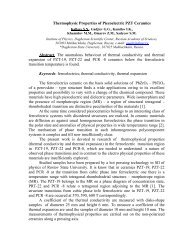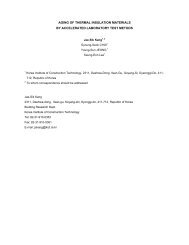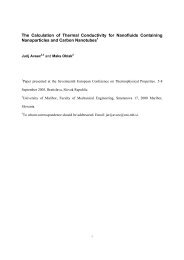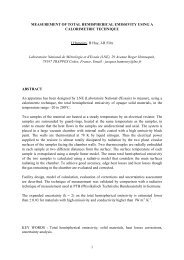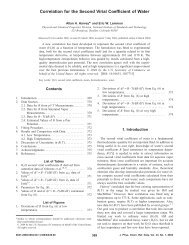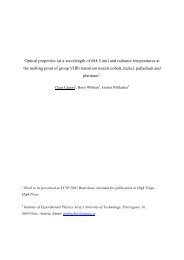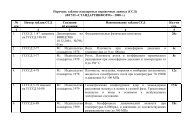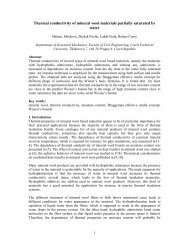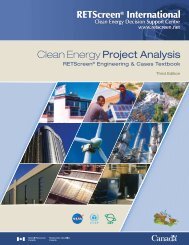Properties of alkali activated aluminosilicate ... - thermophysics.ru
Properties of alkali activated aluminosilicate ... - thermophysics.ru
Properties of alkali activated aluminosilicate ... - thermophysics.ru
You also want an ePaper? Increase the reach of your titles
YUMPU automatically turns print PDFs into web optimized ePapers that Google loves.
on the correspondingly low value. The most probable reason for this behavior was the growth<br />
<strong>of</strong> akermanite crystals on the seeds formed at lower temperatures which was promoted by the<br />
high temperature environment. This statement is supported by XRD results in Fig. 7 where<br />
the amount <strong>of</strong> akermanite phase was remarkably increased. The transition <strong>of</strong> the binder phase<br />
was after heating to 1200 0 C apparently completed. As it is documented in the SEM image <strong>of</strong><br />
the binder-aggregate interface in Fig. 8, the cracks in the binder phase disappeared due to a<br />
sintering process and the contact between aggregates and the new binder phase was<br />
reestablished. Therefore, the improvement <strong>of</strong> mechanical properties was quite logical. The<br />
difference in porosity and thermal conductivity as compared to the reference material was due<br />
to the appearance <strong>of</strong> new binder phase on the basis <strong>of</strong> akermanite which had different<br />
properties than the original CSH st<strong>ru</strong>cture.<br />
Fig. 8 SEM image <strong>of</strong> the aggregate-binder interface after heating to 1200 0 C<br />
5. Conclusions<br />
The results <strong>of</strong> measurement <strong>of</strong> basic, mechanical and thermal parameters <strong>of</strong> the<br />
<strong>aluminosilicate</strong> material based on slag <strong>alkali</strong> <strong>activated</strong> by water glass after thermal load up to<br />
1200 0 C in this paper revealed good perspectives <strong>of</strong> the material in practical applications. The<br />
original CSH st<strong>ru</strong>cture <strong>of</strong> the binder was after high-temperature exposure found to be<br />
gradually replaced by a new st<strong>ru</strong>cture based on akermanite which after heating to 1200 0 C<br />
exhibited superior mechanical properties well comparable with the properties <strong>of</strong> the original<br />
material not subjected to any thermal load. In addition, the porosity <strong>of</strong> the material was after<br />
heating to 1200 0 C significantly increased. This makes very good prerequisites for using the<br />
material in such applications where traditional cement based materials fail, for instance as fire<br />
protection materials, or using it in the form <strong>of</strong> protective layers for the current reinforced<br />
concrete st<strong>ru</strong>ctures, for instance in tunnels. Taking into account that the material is partially<br />
based on waste materials, which serve as secondary raw materials for the forming <strong>of</strong> the<br />
binder system, it is possible to consider it as a low-energy material, so that it meets a trend<br />
common in recent production processes.<br />
10



